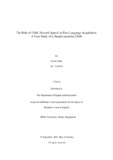The role of child directed speech in first language acquisition: a case study of a Bangla-speaking child
Abstract
This qualitative case study investigates how the family members of a Bangla-speaking child provides child directed speech in his first language acquisition. Naturalistic approach was used to collect video-recording samples of a three years old Bangla speaking child interacting with his family members in a Bangla speaking environment. The results were analysed based on the researchers own idea supported by existing literature. The findings showed both the child and the family members used child directed speech significantly over the period of one month. The findings of the study are important for the caregivers of first language in any ESOL country such as Bangladesh, since the present study works as a guidance for the them.
Keywords
Child directed speech; Caregivers; Features of child directed speech; Halliday’s function of language; First language acquisitionDescription
This thesis is submitted in partial fulfillment of the requirements for the degree of Bachelor of Arts in English, 2021.Department
Department of English and Humanities, Brac UniversityType
ThesisCollections
- Thesis, B.A. (English) [645]

